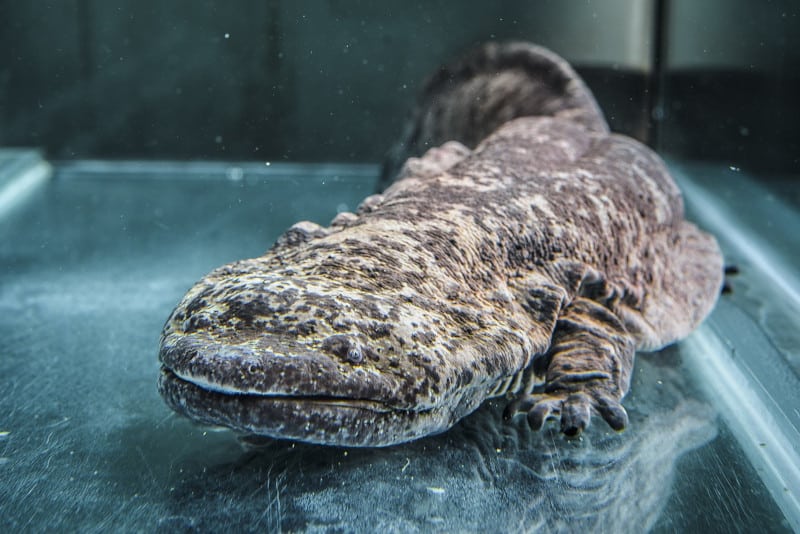Chinese Giant Salamander Facts
- This astonishing work of Nature and evolution bears the informative, as well as accurate, common name of the Chinese Giant Salamander. It also bears another, more difficult to pronounce name. That’s because it holds the scientific name of the Andrias davidianus.
- It received that title due to the efforts of the highly respected French zoologist and entomologist Charles Émile Blanchard. This researcher recorded the first formal recognition of it as a separate and distinct species. This scientifically notable event occurred in 1871.
- For the moment, however, it also serves as the focus of ongoing, serious scientific debate. That’s due to the results of recent DNA research. A 2018 study revealed that several subspecies of the remarkable creature may in fact exist. This would complicate its classification.
- Impressively, the animal holds several distinctions in the annals of science, in fact. The first’s a strongly positive one, of sorts. That’s because it’s presently the largest of all known amphibians. The second, however, isn’t as fortunate. It also remains among the most threatened of them.
- Therefore, the IUCN lists it on the organizations’ published Red List of Threatened Species. On that list, it holds the regrettable status of Critically Endangered. The remarkable amphibian currently faces several threats to its existence, including habitat loss and human consumption.
- Unfortunately, the breathtaking Chinese Giant Salamander now finds itself in dire straits. It’s facing multiple threats to its continued existence as a species. Like most forms of life on earth today, most of these stem from the actions of man. They include the threat of climate change.
Related Articles
Chinese Giant Salamander Physical Description
The mind-blowing Chinese Giant Salamander virtually never fails to immediately grab the attention of anyone fortunate enough to encounter one of these creatures in the wild. Unlike the vast majority of its numerous relatives around the world, though, it does so due to its astounding size.
In referencing its physical attributes, it must be noted that it distinguishes itself from many animals in a distinctive manner. That’s because this work of Nature displays no noticeable degree of the physiological characteristic of sexual dimorphism. Though not unknown, it’s certainly uncommon.
The lone known exception to this somewhat uncommon fact occurs during its mating season. That’s because, at that specific time, certain glands of the males swell temporarily. With that sole exception, the two genders of the species remain virtually indistinguishable to the naked eye.
More precisely, specimesn of both genders frequently grow to relatively enormous sizes, as the common name clearly implies. A mature individual attains an average length equaling an amazing 3.8 ft (1.16 m). These same specimens average a body weight of about 55 – 66 lb (24.9 – 29.9 kg).
Naturally, exceptional specimens do sometimes occur, however. In fact, some rare examples occasionally attain lengths reaching as great as 5.9 ft (1.8 m). The weight of these same creatures sometimes equals a much as 130 lb (59 kg). The Chinese Giant Salamander clearly earns its name.
Its also has a very startling, wrinkly appearance. In color, the animl usually presents a background of dark brown, with a speckled or mottled pattern present. Some, though, can be dark brown, reddish, or even black. The creature further has an outsized head, wide mouth, and small, lidless eyes.
- Kingdom: Animalia
- Phylum: Chordata
- Class: Amphibia
- Order: Urodela
- Family: Cryptobranchidae
- Genus: Andrias
- Species: A. davidianus
Chinese Giant Salamander Distribution, Habitat, and Ecology
The very name of the awesome Chinese Giant Salamander obviously provides a clue to its native range. To the knowledge of science, this magnificent creature lives only in the portion of Asia that now forms the country of China. Even there, though, its locality remains somewhat limited.
Previously, the astonishing wonder of Nature seemed to be widespread across southern, southwest, and central China. Now, however, that endemic range appears to be highly broken in nature. The known populations appear from Qinghai to Jiangsu, to Guangxi, Guangdong, and Sichuan.
The greatest known concentrations additionally appear within three large river basin regions located in the area. These areas consist of the Pearl River, the Yellow River, and the Yangtze. Still another small population of these giant amphibians potentially exists somewhere on the Tibetan Plateau.
It also seems to have a reasonably strong preference for certain altitudes, where its choice of habitat is concerned. That’s due to the fact that most specimens appear at heights from between 300 – 4,900 ft (100 – 1,500 m). One exception, though, is a grouping living at 13,800 ft (4,200 m).
This remarkable animal also evolved as entirely aquatic in nature. Individuals principally live in lakes with very clear water, and rocky streams situated in the hills. In these specific locations, most make their home along the banks, typically in regions where dark, rocky crevices line those banks.
The Chinese Giant Salamander, like most of its kind, evolved as a pure carnivore. Its known prey consists of a wide variety of local species. These include millipedes, insects, freshwater crabs, fish, and even small shrews. Intriguingly, this natural wonder itself has no known natural predators.
Species Sharing Its Range
Red Panda
Check out our other articles on 5 Vibrant Invertebrates of Vermont, Hyacinth Macaw, Christmas Island, Eurasian Red Squirrel, Red-Tailed Bumblebee, North Atlantic Right Whale, Achiote Tree

